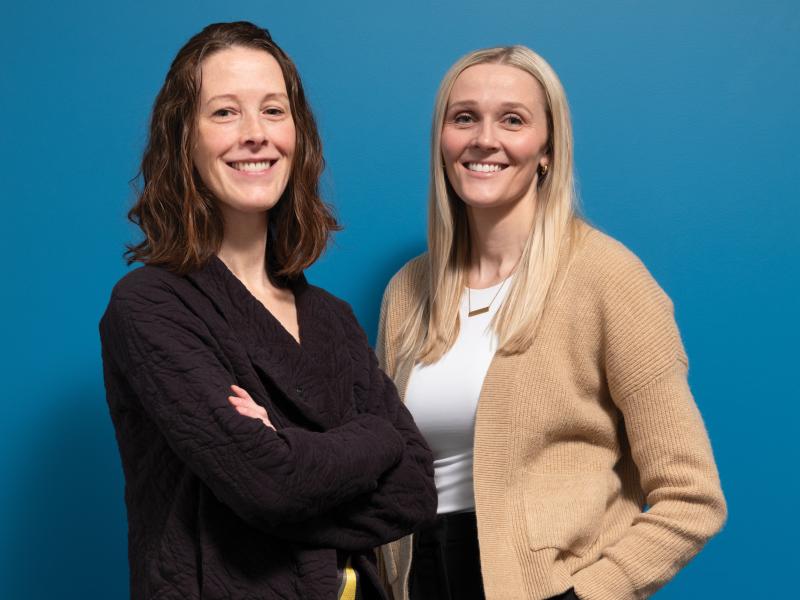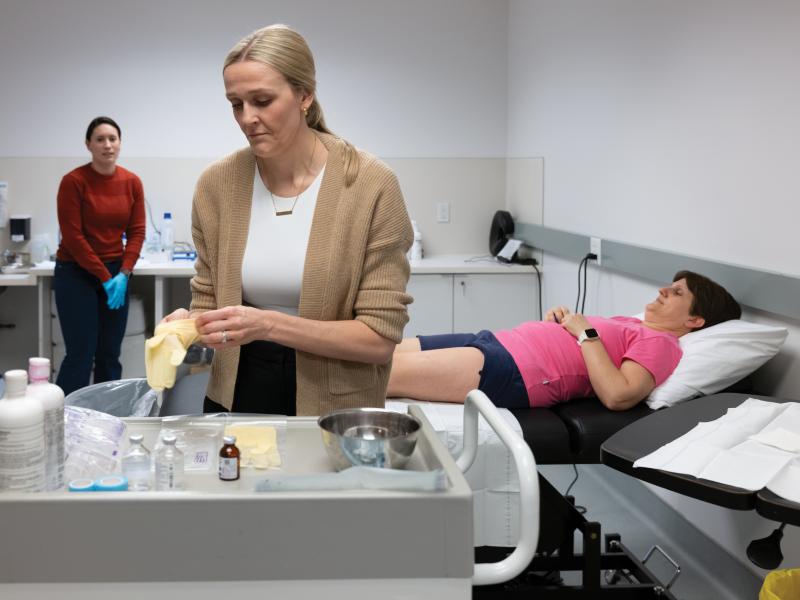Assistant Professor Amy Kirkham was reading a historical review of the research informing the prevention of heart disease when she was struck with an idea for an ambitious new study.
“The review outlined how the basis for using strategies such as medications and lifestyle changes, including diet and physical activity, to help prevent heart disease stemmed from two major studies based entirely on men,” says Kirkham, whose research is focused on developing evidence-based lifestyle interventions to prevent and improve cardiovascular dysfunction and disease, specifically in women.
The Multiple Risk Factor Intervention Trial, aptly named MRFIT, begun in 1972, and the Physicians’ Health Study, begun in 1982, included approximately 12,000 and 22,000 middle-aged men, respectively. These large-scale studies evaluated the effectiveness of prevention and treatment strategies for heart disease. However, the applicability of the results of these major studies to women raised public concerns about the historical exclusion of women from this type of research.
“The review posed the question of how it is possible that studies of heart disease, a condition known to be the most common cause of death in women, relied solely on male participants?” says Kirkham. “As I was reading this, I felt a fire light under my feet. “I’m pretty sure I wrote an email to Jenna Gillen right after that to say, ‘we need to do a Ms. FIT study for women!’”
Gillen, an assistant professor in KPE focusing on exercise physiology, didn’t need any convincing. “If you look at the landmark studies in muscle physiology that explore responses to exercise, you’ll find that most were conducted in young, healthy males,” Gillen says, “and the reason for not including women in these studies has historically been that women are more complicated to study – among other things, because their hormones change throughout the menstrual cycle, so it’s just easier to study males.
“That got me thinking, rather than it being a challenge or a barrier, isn’t this a good topic for research? How does the menstrual cycle affect muscle physiology and what happens during menopause?” Gillen and Kirkham agreed to join forces on a research project that would measure, for the first time, the impact of following Canada’s physical activity and dietary guidelines on the cardiovascular and metabolic health of pre- and post-menopausal women. True to form, they named the study Ms. FIT.

“Health Canada recommends that all adults follow Canada’s food and physical activity guidelines to help prevent and treat chronic disease,” says Kirkham, “but since most of the research that’s informed these guidelines has been done primarily in men, we don’t actually know whether these are the best guidelines to improve women’s health broadly.
“We also know that women experience different life stages, including pregnancy and postpartum, and pre- to peri- to post-menopause, but without knowing if the existing guidelines are good in general for women, it’s hard to know how they apply to all these different life stages specifically.” To this end, Ms. FIT also includes a sub-study focusing on women with a history of breast cancer, a condition affecting more than two per cent of the female population in Canada.
“Women are not small men,” says Kirkham. “We have different biology and unique needs, so, at minimum, we need new evidence that is specific to women to inform what we’re telling them to do.” The researchers plan to recruit 90 pre-menopausal and 90 postmenopausal women for the study, making it the largest study of its kind. It’s also one of only a few studies in women – or men – to measure the impact of physical activity and food guidelines on such a breadth of biological systems, all in one study under one roof in the research labs housed in the Goldring Centre for High Performance Sport.
“We’re looking at the impact of these guidelines on women’s hearts, blood vessels, skeletal muscle and adipose tissue [body fat] in order to understand where in that chain women experience the most health benefits and whether this differs with menopausal status,” says Kirkham. The researchers say existing evidence shows that a lot of the expected health benefits with exercise are blunted or do not occur in postmenopausal women. For example, aerobic exercise is expected to make the heart grow stronger, however researchers have observed limited positive changes to the heart in pre-menopausal women and almost none in post-menopausal women compared to men. “So, one of the main things that we expect to occur with exercise is not occurring in women,” says Kirkham.
A meta-analysis that looked at results from many different studies investigating the impact of exercise on heart health in male and female participants also found that the effects of aging have a bigger impact on women, in terms of how their hearts respond to training. There are also differences in how the muscles adapt to exercise, although limited studies exist that focus on muscle physiology in females specifically.
“We don’t have a meta-analysis that would demonstrate so profoundly the differences between males and females, but we do know some aspects of metabolism differ,” says Gillen. “For example, females burn different fuels than males during exercise. While males tend to burn carbohydrates, females burn more fats or lipids for fuel, which can affect their responses to exercise.”
The researchers will take thigh muscle biopsies in about half of the study participants, which is far more than most muscle physiology studies, according to Gillen, who says typically these studies have sample sizes of 10 or less per studied group. In part, she explains, that’s because of the invasive nature of muscle biopsies, as well as the cost that comes with all the consumables required for the molecular analysis.

Enter Daniel Moore, a professor in KPE specializing in muscle physiology, who’s been making his own contributions to address the imbalances in the study of women’s health by researching, among other things, the differences in protein requirements between male and female endurance athletes. Moore volunteered to perform the muscle biopsies for the Ms. FIT study and simultaneously trained Gillen to start doing them as well.
Professor Catherine Sabiston has also offered to help, giving Gillen and Kirkham the use of her Mental Health and Physical Activity Research Centre (MPARC) for exercise training sessions that are part of the study.
Having the support of full professors has been helpful and encouraging, say Gillen and Kirkham, who are leading this study with contributions from two other early career faculty members, Associate Professor Linda Trinh, who specializes in exercise oncology, and Assistant Professor Robert Bentley, who has expertise in cardiovascular physiology. Trinh is a co-investigator on the project, lending her expertise in behaviour change to the development of remote exercise and education sessions in the Ms. FIT study.
Trinh’s graduate student is working as a trainer for these exercise sessions, some of which take place in her exercise oncology lab, and has made the study’s evaluations of the barriers and facilitators to exercise the basis of her master’s thesis.
Bentley has been supporting the study by contributing his expertise in cardiac and vascular assessments and sharing equipment necessary for the project. His graduate student is also working as a paid trainer for the study.
With nearly half of the 180 study participants already recruited, the researchers are busy with data collection. They’re working on three fronts at the moment: conducting initial testing of new study recruits to analyze their hearts, vessels and muscles at baseline; following a group of participants who have started the six-month-long intervention; and doing assessments of the study participants who have completed the intervention to identify any changes to their cardiometabolic systems. They estimate the data will take around two and a half years to collect, taking them to the end of 2026.
“We hope the information we generate will inform new guidelines, but also lead to other important outcomes, such as the development of the first-ever women-specific exercise physiology textbook – and course,” says Kirkham. “Wouldn’t it be impactful if our Faculty was leading the world in that area?”

Kirkham and Gillen are also very proud of their focus on training the next generation of scientists in women’s physiology, with so many KPE students, post-doctoral fellows and staff working on the study. Alfred Min, a first-year PhD student in KPE, joined Kirkham’s lab as a master’s student interested in exercise interventions for improving physiological outcomes. He worked on a precursor to Ms. FIT – a six-week condensed version of the study. That work recommended him for the position of lead exercise trainer in the Ms. FIT study today.
“This has been a unique learning experience,” says Min. “Interacting with study participants has allowed me to observe how regular exercise improves various physiological health outcomes while positively impacting the study participants’ lives.”
Ms. FIT is funded by a close to $1M grant from the Canadian Institutes of Health Research (CIHR), one of the biggest CIHR grants in KPE history. Kirkham and Gillen also recently received funding from the Canadian Foundation for Innovation (CFI) for infrastructure and equipment for their new lab, which they’re calling the Centre for Cardiometabolic Oncology, Diet and Exercise Research in Women (CODE-W). CODE-W will tackle critical gaps in women’s health by generating new knowledge that will inform prescriptions for physical activity and nutrition interventions for the prevention and treatment of cancer, cardiovascular disease and type 2 diabetes in women. It will also provide a training environment that will empower the next generation of scientists and clinicians working on women-centred research.
Kirkham and Gillen are also eager to highlight the support they were provided by Professor Gretchen Kerr, dean of KPE, for their work. “She understands the challenges that come with being a woman in science trying to run a research lab and conduct studies with women participants,” says Gillen. With Kerr’s support, the researchers were able to hire a phlebotomist, who’s now working part-time in the Faculty to help with blood draws in women, who generally tend to have smaller veins.
“That’s another reason why women aren’t studied, because they are harder to test; their muscles, veins and hearts are smaller, so data collection is often more difficult,” says Gillen.
Women also have other unique barriers to participation in research, including limited availability because they generally take on more house care and caregiving responsibilities. “The Ms. FIT study, and all other research projects conducted under the umbrella of CODE-W, are very intentional about removing barriers that have historically limited the participation of women in research,” says Kirkham.
Study participants are offered flexible schedules, financial support for time off work and child or elder care, female study staff and remote participation to help them balance their busy lives. “In turn, our participants have been excited to be part of this historic research that has the potential to change what we know about women’s exercise physiology and chronic disease prevention in women,” says Kirkham. “This research would not be possible without them, and we are so grateful for their participation.”
This piece appeared as the cover story in the spring 2025 issue of Pursuit, KPE's alumni magazine. Read the full issue here.
